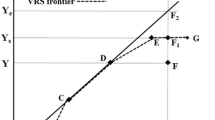Abstract
This paper develops a dynamic–network DEA (data envelopment analysis) model where total output is jointly produced from two sectors: a human capital sector and a physical capital sector. Each prefecture produces a final output and an intermediate product which is used to augment future physical capital. The optimization method allows future production possibilities to be enhanced if some final output in the current period is foregone so that larger amounts of the intermediate product can be produced. The goal is to choose the amounts of final output and intermediate product so as to maximize the size of the production possibility set. The method also allows identification of whether output is constrained by a lack of physical capital, a lack of human capital or a lack of both types of capital. We apply our method to 47 Japanese prefectures during the period 2007–2009. A key finding is that a lack of human capital is constraining potential output.




Similar content being viewed by others
Notes
Fukuyama and Mirdehghan (2012) discuss the identification of divisional efficiency from a Pareto–Koopmans efficiency perspective.
Fukao and Yue (2000) estimated this index for the period 1955–1995.
For a complete account of Fukao and Yue (2000)’s procedure, see http://www.ier.hit-u.ac.jp/~fukao/japanese/data/fuken2000/datamaking.
The regions (prefectures within each region) from northeast to southwest in Japan are Hokkaido–Tohoku (Hokkaido, Aomori, Iwate, Miyagi, Akita, Yamagata, Fukushima), Kanto (Ibaraki, Chiba Tochigi, Tokyo, Gumma, Kanagawa, Saitama, Yamanashi, Nagano), Hokuriku–Toukai (Niigata, Gifu, Toyama, Shizuoka, Ishikawa, Aichi, Fukui, Mie), Kansai (Shiga, Kyoto, Osaka, Hyogo, Nara, Wakayama), Chugoku–Shikoku (Tottori, Tokushima, Shimane, Kagawa, Okayama, Ehime, Hiroshima, Kochi, Yamaguchi) and Kyusyu–Okinawa (Fukuoka, Okinawa, Saga, Nagasaki, Kumamoto, Oita Miyazaki, Kagoshima).
We used a linear interpolation technique to interpolate the values between 2007 and 2009 because the ministry only report the traveling time estimates every 5 years.
To obtain the parameter estimates based on bootstrap regression analysis, we adapted the R-Package called ‘rDEA’ developed by Jaak Simm and Galina Besstremyannaya (2016) (see the Web site https://github.com/jaak-s/rDEA maintained by Jaak Simm).
References
Akther S, Fukuyama H, Weber WL (2013) Estimating two-stage network slacks-based inefficiency: an application to Bangladesh banking. Omega 41:88–96
Aoki I (2008) Decentralization and intergovernmental finance in Japan. Policy Research Institute, Ministry of Finance, PRI Discussion Paper Series (No.08A-04)
Badunenko O, Henderson DJ, Russell RR (2013) Polarization of the worldwide distribution of productivity. J Prod Anal 40(2):153–171
Bogetoft P, Färe R, Grosskopf S, Hayes K, Taylor L (2009) Dynamic network DEA: an illustration. J Oper Res Soc Jpn 52:147–162
Chen Y, Cook WD, Kao C, Zhu J (2013) Network DEA pitfalls: divisional efficiency and frontier projection under general network structures. Eur J Oper Res 226:507–515
Chen C-M, Van Dalen J (2010) Measuring dynamic efficiency: theories and an integrated methodology. Eur J Oper Res 203:749–760
Emrouznejad A, Thanassoulis E (2005) A mathematical model for dynamic efficiency using data envelopment analysis. Appl Math Comput 160(2):363–378
Färe R, Grosskopf S (2000) Network DEA. Soc-Econ Plan Sci 34:35–49
Färe R, Grosskopf S (1996) Intertemporal production frontiers: with dynamic DEA. Springer, Dordrecht
Färe R, Fukuyama H, Weber WL (2010) A mergers and acquisitions index in data envelopment analysis: an application to Japanese Shinkin Banks in Kyushu. Int J Inf Syst Soc change 1(2):1–18
Fukao K, Yue X (2000) Regional factor inputs and convergence in Japan: How much can we apply closed economy neoclassical growth models? (in Japanese). Econ Rev (Keizai kenkyu) 51:136–151
Fukuyama H, Mirdehghan SM (2012) Identifying the efficiency status in network DEA. Eur J Oper Res 220:85–92
Fukuyama H, Weber WL (2013) A dynamic network DEA model with an application to Japanese cooperative Shinkin banks. In: Pasiouras F (ed) Efficiency and productivity growth. Modelling in the Financial Services Industry, Wiley, London Chapter 9
Henderson DJ, Russell RR (2005) Human capital and convergence: a production frontier approach. Int Econ Rev 46(4):1167–1205
Li Q (1996) Nonparametric testing of closeness between two unknown distributions. Econm Rev 15(3):261–274
Nemoto J, Goto M (2003) Measurement of dynamic efficiency in production: an application of data envelopment analysis to Japanese electric utilities. J Prod Anal 19:191–210
Otsuka A, Goto M, Sueyoshi T (2010) Industrial agglomeration effects in Japan: productive efficiency, market access, and public fiscal transfer. Pap Reg Sci 89(4):819–849
Simar L, Wilson PW (2007) Estimation and inference in two stage, semi-parametric models of productive efficiency. J Econm 136:31–64
Simar L, Zelenyuk V (2006) On testing equality of distributions of technical efficiency scores. Econm Rev 25:497–522
Sueyoshi T, Sekitani K (2005) Returns to scale in dynamic DEA. Eur J Oper Res 161:536–544
Tone K, Tsutsui M (2010) Dynamic DEA: a slacks-based measure approach. Omega 38:145–156
Tone K, Tsutsui M (2014) Dynamic DEA with network structure: a slacks-based measure approach. Omega 42(1):124–131
United Nations Human Settlements Programme (2012) Fiscal decentralization in Japan. The global urban economic dialogue series. UN-HABITAT, Nairobi
Author information
Authors and Affiliations
Corresponding author
Rights and permissions
About this article
Cite this article
Fukuyama, H., Hashimoto, A., Tone, K. et al. Does human capital or physical capital constrain output in Japanese prefectures?. Empir Econ 54, 379–393 (2018). https://doi.org/10.1007/s00181-016-1202-5
Received:
Accepted:
Published:
Issue Date:
DOI: https://doi.org/10.1007/s00181-016-1202-5




